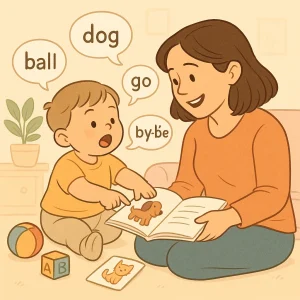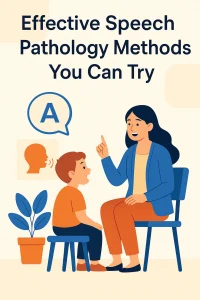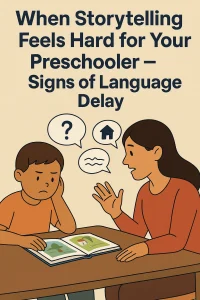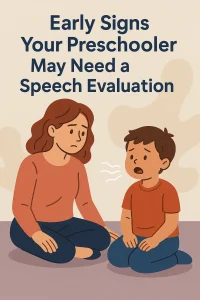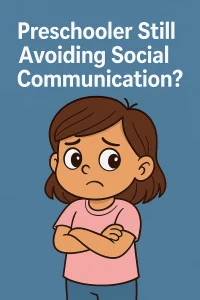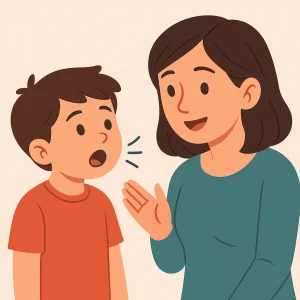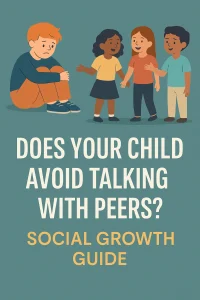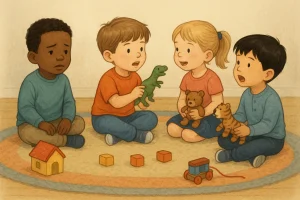Using Speech Play to Help Your Toddler Follow Simple Directions
Last Updated: July 14, 2025
Is your toddler struggling to follow simple directions during play or daily routines? Speech play offers a fun and engaging way to improve listening, comprehension, and communication skills. By turning everyday moments into interactive games, you can help your toddler follow instructions more confidently—while boosting early language development. In this guide, we’ll share therapist-recommended speech play strategies to make learning easy and enjoyable for your child
Free Speech Help for Kids
Concerned about speech delays? Book a free consultation with our expert speech therapist and get guidance tailored to your child’s needs.
Why Speech Play is Crucial for Your Toddler’s Development
What is Speech Play for Toddlers?
Speech play refers to fun, interactive activities that encourage toddlers to use their voices, understand language, and practice communication skills. These activities can include anything from playing with toys that require verbal interaction to simple games like “Simon Says” that involve following directions.
At this stage of development, toddlers are exploring their world through language, and speech play is an essential tool for helping them develop the skills they need for effective communication.
Importance of Speech Play in Toddler Communication
As toddlers begin to understand more words and phrases, their ability to follow simple directions becomes crucial for everyday learning and development. Speech play helps strengthen the link between what toddlers hear and what they can express. Through activities like singing, talking, or mimicking sounds, toddlers learn to connect words to actions, building a strong foundation for understanding and following instructions.
How Speech Play Improves Communication Skills
These activities to build toddler communication skills reinforce important milestones like listening and following through on instructions.
- Encourages Listening: Through speech play, toddlers practice active listening. Games where they must follow verbal cues, like “Touch your nose,” help them tune into language and understand how it works in different contexts.
- Builds Vocabulary: As toddlers engage in speech play, they are exposed to a variety of words in a fun and memorable way. The more words they hear and use, the better they can understand instructions and express themselves.
- Promotes Social Interaction: Speech play often involves turn-taking and interaction with others, which helps toddlers develop social communication skills. Whether it’s mimicking animal sounds or playing a game that involves giving directions, these interactions build not just language skills but also social cues.
- Fosters Confidence: When toddlers see that they can successfully follow simple instructions or use words in play, it boosts their confidence in their communication abilities. This builds a positive cycle of more practice and greater skill development.
How Speech Play Helps Your Toddler Follow Simple Directions
Building Understanding Through Play
Speech play activities are more than just fun; they are powerful tools to help your toddler grasp the concept of following directions. Think of activities like “Simon Says” or “Follow the Leader” — these simple games are perfect examples of how you can teach your toddler to understand and follow verbal instructions.
When you give your toddler a simple instruction during a play session, like “clap your hands” or “touch your nose,” they begin to link the words they hear with actions. Over time, this helps your child build the ability to understand what different instructions mean and how to carry them out.
How It Works:
- Repetition: The more your toddler hears and practices following commands, the easier it becomes for them to understand what you’re asking. Simple instructions like “jump,” “sit,” or “wave” are repeated in a playful context to ensure your toddler internalizes the connection between words and actions.
- Interactive Learning: Speech play activities offer interactive opportunities where your toddler can immediately act on the instructions given. This direct connection between hearing the instruction and performing the action builds a stronger understanding of following directions.
Using Speech Play to Develop Listening Skills
Listening is at the heart of following directions. By engaging in speech play, your toddler gets plenty of practice listening to verbal cues and acting on them. As toddlers develop their listening skills, they become better at understanding the instructions they hear and can more easily follow them, whether at home or in other environments.
How It Enhances Comprehension:
- Focused Listening: In speech play, toddlers need to pay attention to each instruction to understand what to do next. For example, during a game, if the instruction is to “hop like a frog,” they need to focus on hearing the full direction and understand it. By repeatedly practicing this, their listening and comprehension abilities improve.
- Building Attention Span: Games that involve following instructions help your toddler develop the ability to stay focused for short periods. This is an essential skill for daily activities, such as listening to a teacher at school or following directions at home.
- Encourages Engagement: Toddlers are more likely to engage when they are part of a fun and interactive activity. Speech play keeps them motivated to listen closely, which reinforces the importance of following instructions while having fun.
Fun Speech Play Activities to Improve Direction Following
Interactive Games for Toddlers
Speech play games are not only fun, but they also provide a fantastic opportunity for toddlers to practice following simple directions. Here are some interactive games that will engage your toddler while helping them develop the skills needed to follow instructions:
- Simon Says
- How it works: In this classic game, you give instructions like “Simon says, touch your nose” or “Simon says, hop like a bunny.” If you say something without adding “Simon says,” your toddler shouldn’t follow the instruction.
- Why it’s great: This game encourages listening closely and helps toddlers learn to follow instructions while also teaching them to pay attention to specific details. It’s fun and interactive, making it easy for toddlers to stay engaged.
- Follow the Leader
- How it works: In this game, you act as the leader and give instructions like “walk in a circle” or “jump three times.” Your toddler has to follow your movements and actions.
- Why it’s great: It allows toddlers to mimic actions while listening to simple directions, reinforcing the concept of following instructions through movement. It also strengthens motor skills as toddlers follow your lead.
- Musical Chairs
- How it works: Play music while your toddler walks around a circle of chairs. When the music stops, they need to find a chair to sit in. You can add variations by giving different instructions like “sit down with your legs crossed” or “stand on one foot.”
- Why it’s great: This game builds listening skills and encourages your toddler to follow instructions while adding an element of excitement. It’s also an excellent way to improve their ability to act quickly on verbal cues.
- Hot and Cold
- How it works: Hide a small object in the room and give your toddler verbal clues like “hot” when they’re getting closer and “cold” when they’re farther away. The goal is for them to find the object based on your verbal directions.
- Why it’s great: It combines listening with problem-solving. Toddlers learn to follow directional cues and understand how listening carefully can help them solve a task.
- Animal Movements
- How it works: Ask your toddler to move like different animals, such as “hop like a frog,” “waddle like a penguin,” or “crawl like a bear.” This activity can be done in the form of a simple game or as part of an exercise routine.
- Why it’s great: It’s an interactive way for toddlers to practice listening, follow directions, and mimic actions. This also helps with gross motor skills as they perform various movements.
Want more activities like “Simon Says” to boost your toddler’s communication? Check out our First Words Flashcards for interactive fun.
Everyday Activities as Speech Play
In addition to formal games, everyday routines are a great way to reinforce following instructions through speech play. Here are a few simple, everyday activities you can turn into speech play opportunities:
- Tidying Up: Encourage your toddler to follow simple instructions like “put the blocks in the basket” or “bring me the red toy.” By using clear and simple directions, you help them understand cause and effect through actions.
- Getting Dressed: Give your toddler instructions like “put on your shoes,” “pull up your pants,” or “button your jacket.” These actions are part of their daily routine, and with a little guidance, they can practice following directions while accomplishing essential tasks.
- Mealtime: During meals, ask your toddler to follow instructions like “pass the salt” or “take a bite.” This can help them practice listening skills while engaging in a routine activity they enjoy. You can also use mealtime to teach simple concepts such as “eat with your spoon” or “drink from your cup.”
- Cleaning Up: After playtime, turn cleanup into a direction-following activity. Say things like “put your toys in the box” or “wipe the table with the cloth.” These everyday tasks help reinforce the connection between verbal instructions and actions, all while promoting responsibility.
- Bath Time: You can incorporate simple instructions into bath time by saying, “wash your feet,” “rinse your hair,” or “get the soap.” Bath time offers plenty of opportunities to practice listening and following directions in a safe, playful environment.
Tips for Encouraging Your Toddler to Follow Simple Directions Through Speech Play
Be Clear and Consistent in Instructions
When it comes to helping your toddler follow simple directions, clarity is key. Clear instructions give your toddler a better chance of understanding what you expect and following through. Here are a few tips on how to provide instructions in a way that maximizes your toddler’s understanding:
- Keep Instructions Simple: Use short, simple phrases that your toddler can easily understand. For example, say “clap your hands” instead of “can you please clap your hands so I know you’re paying attention?”
- Avoid Overloading: Stick to one instruction at a time. Giving multiple instructions in one go can confuse toddlers, making it harder for them to follow through. For instance, say “pick up the book” and once that’s done, add “put it on the shelf.”
- Use a Calm and Steady Tone: The tone of your voice also matters. A calm, steady tone helps your toddler focus on what you’re saying and makes it easier for them to listen and act.
Consistency is equally important. Use the same words for instructions and try to maintain a routine. For example, always say “wash your hands” instead of switching between “clean your hands” or “go wash your hands,” as consistency helps toddlers make connections between words and actions.
Use Visuals and Gestures to Enhance Understanding
Sometimes, words alone may not be enough for toddlers to fully grasp what you mean. Adding visuals and gestures can significantly improve their understanding of instructions, making it easier for them to follow through. Here’s how you can incorporate visuals and gestures into speech play:
- Pointing: While giving instructions, use your finger to point at the object you want them to interact with. For example, if you’re asking them to pick up a toy, point to the toy as you say, “Pick up the toy.”
- Using Toys or Objects: Toddlers learn well by mimicking. You can use a toy to demonstrate the action you want them to follow. For example, if you’re playing “Simon Says” and asking them to “jump like a frog,” use a toy frog to show them how to do it first.
- Gestures: Incorporating gestures such as waving your hand to show “come here” or patting your lap to signal “sit down” can make directions more relatable and clear for your toddler.
- Demonstrating Actions: Sometimes, toddlers need to see an action to understand it. If you ask them to “put the cup on the table,” demonstrate it first. Showing them the action reinforces the verbal instruction and helps them understand exactly what to do.
- Using Visual Cues: You can also use charts, flashcards, or drawings that display simple actions like “stand up,” “sit down,” or “clap hands.” These visuals will help toddlers connect the words with the physical actions they need to follow.
Conclusion
Speech play is a fun and effective way to help your toddler follow directions and build strong language skills. By turning everyday activities into opportunities for learning, you can set your child up for future success in communication. Ready to take the next step? Wellness Hub offers personalized therapy programs designed to boost your toddler’s speech and language development. Explore our services today and give your child the tools they need to thrive!
Explore Wellness Hub’s speech therapy tools designed to make learning fun for toddlers. Start your journey today.
Frequently Asked Questions:
1. What is speech play for toddlers?
Speech play is when you use fun activities to help your toddler learn language and improve their communication skills. It can include simple games like “Simon Says” or everyday tasks where you give instructions, like “clap your hands.”
2. How can speech play help my toddler follow directions?
Speech play helps your toddler connect words with actions. By playing games or using simple instructions, your child learns how to listen and follow directions in a fun, engaging way.
3. What are some fun speech play activities for toddlers?
Some great activities include:
- “Simon Says” for listening and following directions
- “Follow the Leader” for mimicking actions
- Everyday tasks like cleaning up or getting dressed
These games encourage toddlers to follow instructions while having fun!
4. How do I teach my toddler to follow directions using speech play?
To teach your toddler, start with clear and simple instructions. Use gestures, point to things, or demonstrate actions. Play interactive games that involve listening, like “Simon Says” or “Hot and Cold.”
5. Why is listening important for toddlers in speech play?
Listening is key for toddlers to understand and follow directions. Through speech play, they learn to focus and listen carefully to your instructions, helping them improve their comprehension and action skills.
6. How can I make speech play more engaging for my toddler?
Make speech play exciting by incorporating gestures, visuals, and toys. Use actions like pointing or showing with your hands. Simple and fun instructions like “jump” or “clap” keep them engaged and learning.
7. How does speech play help with my toddler’s language development?
Speech play boosts your toddler’s language skills by encouraging them to listen, understand, and speak. It helps them build vocabulary, improve communication, and practice following instructions.
8. When should I worry if my toddler isn’t following directions?
If your toddler struggles with simple tasks or doesn’t respond to instructions, it could be a sign they need extra support. Speech delays or hearing problems might be factors. It’s a good idea to consult a speech therapist if you’re concerned.
9. Can I use everyday activities to improve my toddler’s speech?
Yes! Everyday tasks like cleaning up, getting dressed, or mealtime can be turned into speech play. Give simple instructions like “put your shoes on” or “clean up your toys” to help your toddler practice following directions.
10. How can Wellness Hub help my toddler with speech development?
Wellness Hub offers personalized speech therapy programs for toddlers. Our expert-led sessions include speech play techniques that help your child improve listening, following directions, and developing communication skills.
About the Author:
Shravanaveena Gajula
M.Sc ., Speech and Language Pathology (5+ years of experience)
Shravanaveena Gajula is a dedicated Speech-Language Pathologist with a BASLP and an M.Sc in Speech and Language Pathology. With experience spanning multiple settings, including Wellness Hub , Veena specializes in a wide range of disorders from developmental issues in children to speech and language assessments in adults. Her expertise includes parent counseling, managing speech sound and fluency disorders, and creating individualized therapy programs. Veena is also PROMPT certified and an author of several insightful blogs on speech and language pathology, aiming to educate and assist caregivers in supporting their loved ones.
Book your Free Consultation Today
Parent/Caregiver Info:
Client’s Details:
* Error Message
